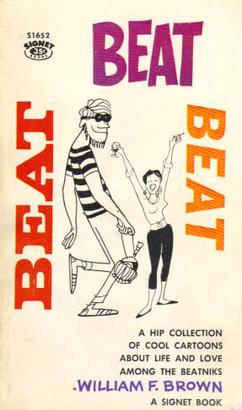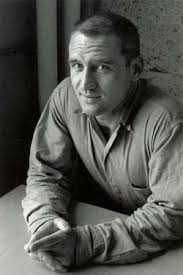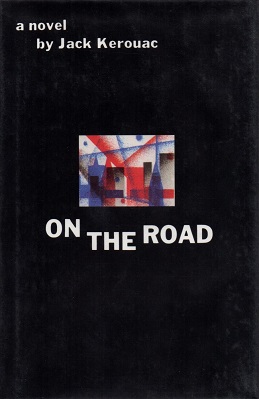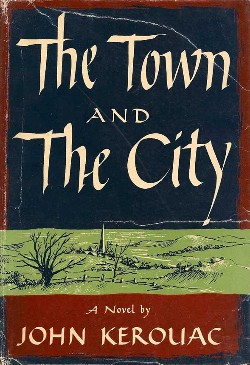
Jean-Louis Lebris de Kérouac, known as Jack Kerouac, was an American novelist and poet who, alongside William S. Burroughs and Allen Ginsberg, was a pioneer of the Beat Generation.

Beatniks were members of a social movement in the mid-20th century, who subscribed to an anti-materialistic lifestyle. They rejected the conformity and consumerism of mainstream American culture and expressed themselves through various forms of art, such as literature, poetry, music, and painting. They also experimented with spirituality, drugs, sexuality, and travel. The term "beatnik" was coined by San Francisco Chronicle columnist Herb Caen in 1958, as a derogatory label for the followers of the Beat Generation, a group of influential writers and artists who emerged during the era of the Silent Generation's maturing, from as early as 1946, to as late as 1963, but the subculture was at its most prevalent in the 1950s. This lifestyle of anti-consumerism may have been influenced their generation's fuel of living in extreme poverty in the Great Depression during their formative years, seeing slightly older people serve in WWII and being influenced by the rise of left-wing politics and the spread of Communism. The name was inspired by the Russian suffix "-nik", which was used to denote members of various political or social groups. The term "beat" originally was used by Jack Kerouac in 1948 to describe his social circle of friends and fellow writers, such as Allen Ginsberg, William S. Burroughs, and Neal Cassady. Kerouac said that "beat" had multiple meanings, such as "beaten down", "beatific", "beat up", and "beat out". He also associated it with the musical term "beat", which referred to the rhythmic patterns of jazz, a genre that influenced many beatniks.

The Beat Generation was a literary subculture movement started by a group of authors whose work explored and influenced American culture and politics in the post-World War II era. The bulk of their work was published and popularized by Silent Generationers in the 1950s, better known as Beatniks. The central elements of Beat culture are the rejection of standard narrative values, making a spiritual quest, the exploration of American and Eastern religions, the rejection of economic materialism, explicit portrayals of the human condition, experimentation with psychedelic drugs, and sexual liberation and exploration.

Neal Leon Cassady was a major figure of the Beat Generation of the 1950s and the psychedelic and counterculture movements of the 1960s.

On the Road is a 1957 novel by American writer Jack Kerouac, based on the travels of Kerouac and his friends across the United States. It is considered a defining work of the postwar Beat and Counterculture generations, with its protagonists living life against a backdrop of jazz, poetry, and drug use. The novel is a roman à clef, with many key figures of the Beat movement, such as William S. Burroughs, Allen Ginsberg, and Neal Cassady represented by characters in the book, including Kerouac, himself, as the narrator, Sal Paradise.

Visions of Cody is an experimental novel by Jack Kerouac. It was written in 1951–1952, and though not published in its entirety until 1972, it had by then achieved an underground reputation. Since its first printing, Visions of Cody has been published with an introduction by Beat poet Allen Ginsberg titled "The Visions of the Great Rememberer."

The Subterraneans is a 1958 novella by Beat Generation author Jack Kerouac. It is a semi-fictional account of his short romance with Alene Lee (1931–1991), an African-American woman, in Greenwich Village, New York. It was the first work of Kerouac’s to be released following the success of On the Road. The Subterraneans and its following novel,The Dharma Bums, both proved to be popular when released in 1958, and are now seen as important works of the Beat Literature. A Hollywood film adaptation would be released in 1960.

Janet Michelle "Jan" Kerouac was an American writer and the only child of beat generation author Jack Kerouac and Joan Haverty Kerouac.

The Town and the City is a novel by Jack Kerouac, published by Harcourt Brace in 1950. This was the first major work published by Kerouac, who later became famous for his second novel On the Road (1957). Like all of Jack Kerouac's major works, The Town and the City is essentially an autobiographical novel, though less directly so than most of his other works. The Town and the City was written in a conventional manner over a period of years, and much more novelistic license was taken with this work than after Kerouac's adoption of quickly written "spontaneous prose". The Town and the City was written before Kerouac had developed his own style, and it is heavily influenced by Thomas Wolfe.

Joyce Johnson is an American author of fiction and nonfiction. She was born Joyce Glassman in 1935 to a Jewish family in New York City and raised in the Morningside Heights neighborhood of Manhattan, a few blocks from the apartment of Joan Vollmer Adams where William Burroughs, Allen Ginsberg and Jack Kerouac lived from 1944 to 1946. She was a child actress and appeared in the Broadway production of I Remember Mama, which she writes about in her 2004 memoir Missing Men.
"Visions of Johanna" is a song written and performed by Bob Dylan on his 1966 album Blonde on Blonde. Several critics have acclaimed "Visions of Johanna" as one of Dylan's highest achievements in writing, praising the allusiveness and subtlety of the language. Rolling Stone included "Visions of Johanna" on their list of the 500 Greatest Songs of All Time. In 1999, Sir Andrew Motion, Poet Laureate of the United Kingdom, listed it as the greatest song lyric ever written.

And the Hippos Were Boiled in Their Tanks is a novel by Jack Kerouac and William S. Burroughs. It was written in 1945, a full decade before the two authors became famous as leading figures of the Beat Generation, and remained unpublished in complete form until 2008.

Visions of Gerard is a novel by American Beat writer Jack Kerouac. Kerouac wrote it over the course of the first two weeks of 1956, while staying with his sister Caroline in Rocky Mount, North Carolina, and it was published in 1963. It is the first volume in Kerouac's "Duluoz Legend". Visions of Gerard focuses on the scenes and sensations of childhood as evidenced in the short yet happy life of his older brother, Gerard. Kerouac paints a picture of the boy as a saint, who loves all creatures and teaches this doctrine to four-year-old Jack. Set in Kerouac's hometown of Lowell, Massachusetts, it is an exploration of the meaning and precariousness of existence.
Carolyn Elizabeth Robinson Cassady was an American writer and associated with the Beat Generation through her marriage to Neal Cassady and her friendships with Jack Kerouac, Allen Ginsberg, and other prominent Beat figures. She became a frequent character in the works of Jack Kerouac.

Poetry for the Beat Generation is the debut album of American novelist and poet Jack Kerouac and was originally released in 1959. Initial performances of these poems were poorly received by an audience at the Village Vangard in 1957. However, Kerouac was so impressed with how the poems sounded when accompanied by Steve Allen's piano that it became the first record Kerouac committed to audio.

Mexico City Blues is a long poem by Jack Kerouac, composed of 242 "choruses" or stanzas, which was first published in 1959. Written between 1954 and 1957, the poem is the product of Kerouac's spontaneous prose technique, his Buddhist faith, emotional states, and disappointment with his own creativity—including his failure to publish a novel between 1950's The Town and the City and the more widely acclaimed On the Road (1957).
Ann Charters is Professor Emerita of American Literature at the University of Connecticut at Storrs. She is a Jack Kerouac and Beat Generation scholar.
Jack Kerouac was an American novelist and poet. He is considered a literary iconoclast and, alongside William S. Burroughs and Allen Ginsberg, a pioneer of the Beat Generation. Kerouac is recognized for his method of spontaneous prose. Thematically, his work covers topics such as Catholic spirituality, jazz, promiscuity, Buddhism, drugs, poverty, and travel. Kerouac used the name "Duluoz Legend" to refer to his collected autobiographical works.
Chicago Review is a literary magazine founded in 1946 and published quarterly in the Humanities Division at the University of Chicago. The magazine features contemporary poetry, fiction, and criticism, often publishing works in translation and special features in double issues.

Readings by Jack Kerouac on the Beat Generation is the third and final spoken word album by the American novelist and poet Jack Kerouac, released in January 1960 on Verve Records. The album was recorded during 1959, prior to the publication of Kerouac's sixth novel, Doctor Sax.














